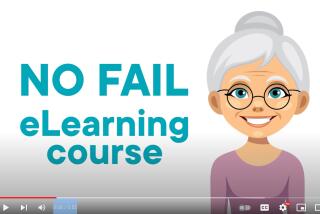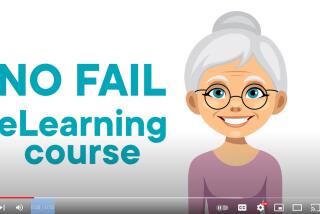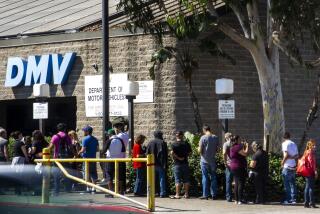U.S. shifting into high gear with new crackdown on drinking and driving
On a dark residential street in Norwalk, Los Angeles Sheriff’s Deputy Alan Healey is lying in wait for his favorite prey: drunk drivers.
Healey snaps to attention when a Chevrolet Suburban blasts through a stop sign at about 30 mph a few blocks from Imperial Boulevard.
“Here we go,” he says as he throws his police cruiser into gear and floors it.
It’s 8:55 on a Friday night -- prime time for drunk-driving arrests.
The war against drunk drivers has been declared by the federal government, but it is waged by local law enforcement officers, who make 1.5 million arrests a year -- or one every 20 seconds.
Federal officials are pushing for all states to adopt a 0.08% blood-alcohol limit on drivers. Most states, including California, have complied, though substantial controversy continues about the effectiveness of such limits and whether regulators have addressed other highway safety problems with the same zeal.
Nonetheless, National Highway Traffic Safety Administrator Jeffrey Runge on Dec. 18 launched a yearlong enforcement campaign to step up the battle against impaired driving, saying it “represents one of our nation’s greatest threats.” The agency spends more than $300 million a year to combat drunk driving.
Back on the front lines in L.A. County, Healey is considered an expert on the subject, having tapped his background as an engineer who once worked on the space shuttle and national aerospace plane programs.
Using his technical knowledge, he has written software that has halved the usual three hours required to arrest and book a drunk-driving suspect.
The driver of the Suburban is a Norwalk resident who coaches Little League and works as a production supervisor at a chrome-plating shop.
He has gone out to pick up some fast food during a break in watching a sports event on television.
“Have you been drinking?” Healey asks.
“I had two Bud Lights,” the driver responds politely, realizing that Healey has probably already smelled beer on his breath.
Bad answer.
Police joke that every drunk driver admits to consuming only two beers because “they can only remember the first one and the last one.”
“Even having one beer in your system will affect your ability to react,” Healey says later, echoing the views of federal safety regulators.
Government agencies disagree about how much a motorist can drink and remain within the law.
Regulations issued by the National Highway Traffic Safety Administration say a 170-pound man would have to down five beers on an empty stomach in an hour to top 0.08%.
But some agencies, including the California Department of Motor Vehicles, put a limit at one or two beers under the same conditions. That’s one reason zero tolerance is the basic message put out by law enforcement officials, whose motto for the coming year’s anti-drunk-driving campaign is “You Drink and Drive, You Lose.”
Police arrest drivers in most states on lesser offenses -- known in California as a “wet reckless” -- if they simply smell alcohol.
Once the Norwalk man admits to drinking, Healey can administer a field sobriety test, a series of routines established by NHTSA to check a driver’s coordination.
The man speaks clearly and politely and engages Healy in small talk about Little League.
The first test is an 18-step “walk and turn,” in which a suspect must walk a straight line, touching heel to toe at each step. Police also ask questions during the test to disrupt the suspect’s concentration.
The Norwalk man lets a foot fall a few inches out of line in one of the 18 steps. Not bad, though suspicious.
Healey asks the driver to raise one leg off the ground to check his balance, a test he passes with flying colors.
Finally, Healey administers a test that measures nystagmus: the involuntary, rapid movement of the eyeball. Alcohol increases the tendency of the eyeball to flutter as it follows an object from side to side -- in this case, a pencil -- and police are trained to assess this fluttering.
The suspect passes.
Drunk-driving attorneys and medical experts who testify in such cases say the tests are often administered incorrectly.
Spurgeon Cole, a Clemson University professor and alcohol researcher, says there is scant evidence to link these tests to actual driving impairment.
“Standing on one leg has nothing to do with driving an automobile,” Cole says. “Some people drive with no legs. We have made all these assumptions, but there aren’t many facts.”
Though the Norwalk man passes most of the tests, Healey still has a hunch the guy may be inebriated. So he asks him to blow into a portable breath-testing machine, a device that helps police screen drivers though it is seldom used as evidence in court.
His blood-alcohol level measures 0.10%.
Healey places the man under arrest and cuffs him.
“I’ve never been in handcuffs before,” the man says.
Once at the Norwalk lockup, the man blows into a Breath Master testing machine, a carefully calibrated device that will report his blood-alcohol level at 0.08, right at the legal limit. The man faces the prospect of thousands of dollars in fines and fees -- and the probable suspension of his license for four months by the Department of Motor Vehicles.
Back on patrol just an hour and 15 minutes after the stop began, Healey acknowledges that the arrest was a borderline case but expresses no regret.
“It is sad,” he says. “This is going to affect him financially pretty badly. But if I let him go with a citation, how would I have felt if he went around the corner and killed a little kid and he had a ticket in his pocket with my name on it?”
*
Ralph Vartabedian can be reached at ralph.vartabedian @latimes.com.
More to Read
Sign up for Essential California
The most important California stories and recommendations in your inbox every morning.
You may occasionally receive promotional content from the Los Angeles Times.











